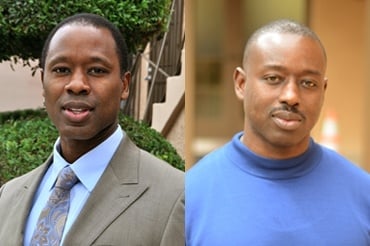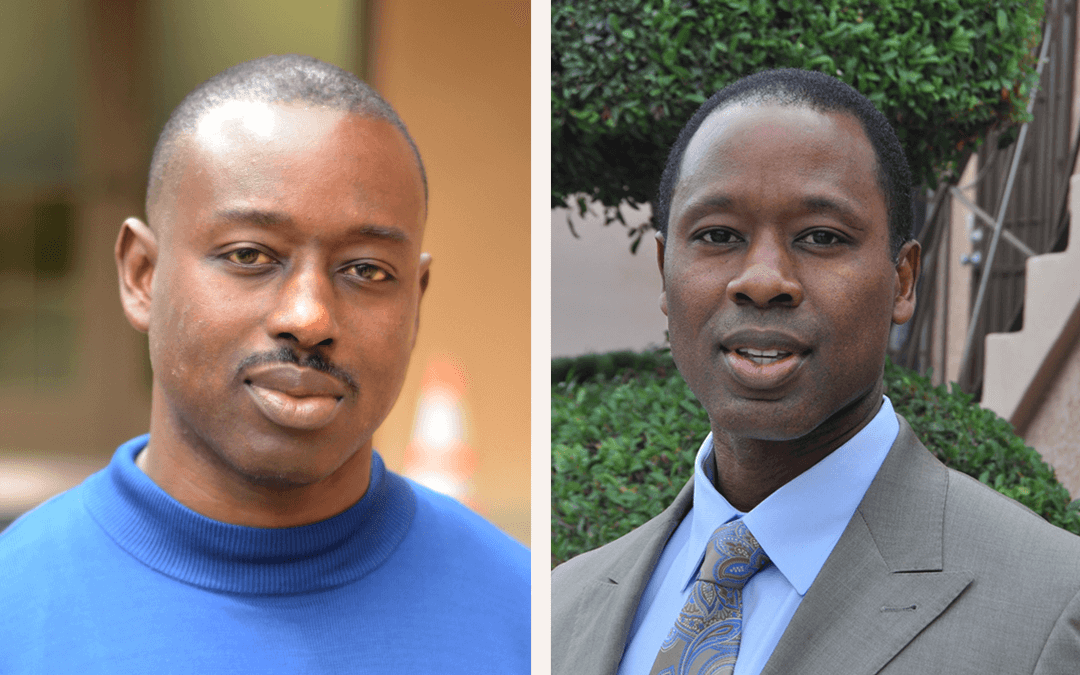Together We Climb, Divided We Fall - FreeFall Writers Sean Finegan and Gregg Maxwell
December 4, 2015
By Zack Gutin
Gregg Maxwell Parker and Sean Finegan met as fraternity brothers at USC. After graduating, Gregg did stand-up and improv while working TV production jobs, while Gregg worked for a major producer, reading scripts. Then, in 2011, they decided to write a script together. Titled Getaway, it sold immediately and became the Ethan Hawke/Selena Gomez thriller. Now, just last month, they had one of the hottest spec scripts of the year, Freefall, spin Hollywood into a dizzying frenzy the way only a small amount of spec scripts do every year. Freefall was acquired by prolific producer Jason Blum and his Blumhouse Films along with Universal Studios.
Explain your writing duo dynamic? How does your collaborative process work?
Greg: Our process has changed a lot over the years. We really didn’t have a handle on the process when we started. We wrote Getaway and it sold very quickly. The next question everyone has is, “What else you got?” but we didn’t have our process down, so we didn’t have that next thing. Now, years later, we’ve refined it to the point where we finish something and immediately we’re working on something else.
Sean: Typically what we’ll do is break story together. That’s a lot of conversational back and forth, a lot of emailing. We both dive into what we like about the idea. Then we start seeing what the other person likes, maybe they’re seeing something that I’m not. So, by the time we arrive at an idea we want to pursue, it’s already gone through a vetting process. The idea has already won over two people.
Greg: If we can zero in on something we both like, the idea has already gone a great distance. Then we’ll start emailing back and forth, adding line by line, to what eventually becomes a 5 to 10 page treatment of everything that’s going to happen in the movie.
Sean: At this point we have a pretty solid grasp, we’ve poked a lot of holes and tried to fill them as we go along. We’ll have the whole movie beat out, then we begin writing and have a very solid road map of the movie. We like to go back and forth with about 5 pages every day. The nice part of having two people is that you can go faster if you’re working at different times of day. There have been times when we’ve off-set our individual clocks so Greg will be working in a 12-hour block, then I’ll pick it up for the next 12-hour block, and we’re able to work really fast.
Greg: The last month or so, I’ve been getting up at 5:00 am and going into Starbucks super early in the morning and writing, so that in the afternoon I can hand something off to Sean and he works through it in the evening. If I write 5 pages in the morning, he can then rewrite those 5 pages and add five pages of his own and suddenly we’ve written 10 pages in a day, rather easily.
Sean: And by the time we get to a first draft, it’s fairly revised. It’s not a vomit draft; parts of it will have been rewritten 10 to 20 times. Once we have that “first draft,” we each take a pass at the entire script.
Greg: That’s my least favorite part. That’s when I’m over-analyzing every piece of grammar and punctuation in a way I would never do normally but [I do it] because I know it’s the last time through before someone else gets to see it.
Sean: And writing is definitely rewriting. Yes, we’re rewriting throughout the whole process, but there’s definitely more to go after that first draft. That’s when we begin including feedback from other people, like our reps. Our reps are very collaborative, they like to get involved creatively, which means you get great input. It means that, even though we want to get that first pass right, we know that things are going to change. We know there are going to be things we didn’t think about, notes that didn’t occur to us at the time.
Greg: We like people who push us, because then you get notes, and sometimes one of us wants to address it one way and one wants to address it another way. The idea is to not just do “my” way or do it “his” way, but to look at the note and think, “Originally, what was the intention of the movie? What were we trying to do?” Throw away everything else and get back to that main idea and how can we make sure whatever decision we’re making on that note, is made to honor the original idea of the movie. That makes it a lot easier to part with things and just try and do whatever you can to build on the original idea.
Sean: And we’ll tell our managers and agents that “soul” of the idea upfront, so that later when we’re diving into these conversations, we all know what we originally intended to do. Those conversations are all in that context and we don’t get bogged down in the minutia. And our team is really good at telling us the “why” of a note, which is really helpful because the reason they’re giving the note is often more important than the note itself.
Breakdown the roller coaster of the week(s) between your script hitting the market and a deal closing? Who were you talking to? Who was calling? Who was reading?
Sean: It was a very eventful week because, not only was our script going out, but also I was getting married. It was a lot of fun. But with specs, a lot is going to happen in a very compressed amount of time. You’ve just spent months, maybe more, pouring your heart and soul into something and your agent is going to go out with it and you’ll know the next morning if people like it or not. You get reads right away and the next day producers will be calling for territories (the studios where they have deals/relationships) and for us, that next morning was really great because we had people calling who wanted to take it in right away. So that’s the first box you have to check: What did the first round of people think? And it’s a thrill. You hope they love it as much as you do, so to hear that is really great. Then you’re waiting … waiting for someone to step up and start the acquisition process. You need someone to put forth a plan as to how they’re going to make the movie and ultimately buy it. There’s not a whole lot you can do at that point, except get married.
Greg: We would hear from our managers at Madhouse 2 to 3 times per day with updates. It’s tough, we always want to know what’s going on, so we jump when the phone rings.
Sean: If you have a good relationship with your reps and you trust them and they believe in you, whatever they’re telling you they’re doing – they’re doing 100x more than that. They’re working tirelessly. It’s almost as if, if you pull them ONTO a call with you, you’re pulling them OFF OF a call with someone else.
Do you guys want to direct? Do you envision drones being used to capture some of the more intense climbing sequences?
Sean: The technology that’s available is so cool. Years ago, what we’re going for would have been impossible. Now it’s possible. We want to slow things down, give people the chance to experience the danger. We want to really own that moment.
Greg: The important part was to make the reader understand what this is going to be like to watch on screen. It’s our job to find a way to communicate that on the page, to inspire them to see it.
The classic “mountain” story structure we all learned as kids seemed to be used in the most literal sense as the characters progress on their climb.
Greg: For us, the organizing of our act structure is a bit more intuitive. If something feels fishy or off, you look at it and find it’s frontloaded or if there is some disconnect in Act Two, but we don’t necessarily need charts or anything like that. We can tell when it’s not fitting the right structure.
Sean: The decisions the characters make are our road map to where we are in the script. With this one, we wanted to do something with the mountain environment. It’s stunningly beautiful, yet hostile and inherently dangerous and it can kill you. So it’s this backdrop for these characters, but the movie really hangs on that relationship between our main characters.
How do you layout those relationships in advance?
Greg: A lot of it is creating the situation, then determining the most interesting characters to go through it. In this story, it’s a father and daughter who are having problems of their own, but now faced with this situation, they have to make decisions that will not only determine what happens to them while they’re on the mountain, but how and if they’re going to be able to go on afterwards.
Sean: The way good concept thrillers work is there would be very little drama without the concept. When you add the concept or the setting, which is whatever makes it a thriller, you add that into the mix and it becomes the inciting incident for the characters to explore the problem they already have.
Given the great climbing detail in the script, I’m assuming one or both of you is a climbing enthusiast.
Greg: Now we are!
Sean: We’ve both camped a little bit and I have these friends I go camping with every year. You go backpacking in the woods, sometimes it’s mountaineering, using basic climbing techniques to hike up the woods. So I thought, “Maybe we know enough,” then we started diving in and figuring out – “What’s going to make them fall, how is this going to happen? The hardest thing we had to do was come up with a plausible way to get these people to fall. Something we learned, while learning about climbing, was that on an individual level, climbing is very dangerous, but it is unusual for there to be an accident that involves BOTH people – or in this case, three people - because usually only one person is moving at one time and the other person is clipped right to the wall.
Greg: That was the frustrating part. When we started learning about climbing, we learned that this accident wouldn’t happen the way we thought it would. So then, knowing what we now knew, you start thinking about it and you find yourself going down this rabbit hole of reading more and more stuff. Sitting there afterhours, suddenly faced with “Oh, I don’t know as much about this as I thought I did, now I better do the learning.”
Getaway is equally fast-moving and concise. Certainly speaks to your voice, perhaps the necessities of the genre ... do you feel it’s a reflection of the market, audiences seeking shorter/faster content rather than longer/slower?
Sean: A lot of the pacing of a film comes down to the director’s decision-making process as to how to execute a moment. The writer has determined what’s going to happen, but what moments are going to be stretched, how they are going to use music and visuals, that’s all the director “conducting the orchestra.” All we try to do is trim the fat, make everything matter.
Greg: We set out to tell the simplest version of a story because we know by the end, it’s going to get longer. If we expect 80 pages, it will be 105 by the end. Start with less, then build – and you’ll still wind up cutting stuff.
Sean: There’s something to be said for letting the reader do at least a little bit with their imagination. We try to write as lean as we can, keep them moving and focused on what you’re trying to do in the moment.
What are the next steps on Freefall and what other projects are up next?
Sean: We’re really happy to be working with the people we’re working with on Freefall; the people at Blumhouse and Universal, our managers are coming on board to produce, too. We’re really pumped about all the people they’re talking to and trying to get involved. The other goal now is to find everyone else who liked the script because we were really fortunate to get a lot of good feedback. The tough thing with a spec is, a lot of people are going to read it, only one group can produce it, and there are a lot of really great people in town we want to work with.
Greg: Without saying too much, we want to try something slightly different than what we did before. Our next thing will not be two people trapped somewhere at all. We’re going to try something different and try to spread our wings a little bit.
Sean: Yeah, it’s not going to be on a mountain.
Greg: Ultimately, what we want to be able to do is not be limited. Our goal for our careers is to get to a place where no matter what we come up with, there’s a way we can get it done. I think we’re well on our way there.
Sean: And that comes from challenging yourself. You want to learn something new, continue to develop your skillset as a writer. You will get better every single time. The more you write, the better you’ll get. You have to push whatever comfort zones, whatever boundaries you’ve created for yourself.
What do you wish you had known in 2011, when you were first starting?
Greg: If I could go back, I would tell us to get writing more scripts right away, because having written a lot of scripts is what prepares you for the process. When we first started, we sold that script really fast but we weren’t prepared to write more and as frequently as we needed to. We really had to train ourselves to do that. So for young writers, you may not sell the script you’re working on right now, but the fact that you’re getting through it means that it’s going to be easier for you to write the next one and the next one. Don’t wait on it! Keep writing as many scripts as you can.
Sean: I would second that. And working with a partner is cool. If I could go back, I’d go past 2011 to 2010 and say, “Start working with Greg sooner!” Writing is a tough job, the odds aren’t good, it’s exhausting and competitive, but when you have a partner, you’re going to push yourself that much harder. We’re working toward this common goal. The micro deadlines we give ourselves means I know, “I have to get this to Greg in 12 hours and if I don’t, then I’m letting Greg down.” Knowing I have to get this to him in 12 hours makes it much easier to stay on task than “I need to be done with this finished in 2 months.”
You guys are obviously close friends. Does that become a challenge?
Greg: You have to know the difference between your friendship and your working relationship, because you need both of these things to be strong and they are not the same thing. People always say things like, “Do it every day,” “Treat it like a job.” Well, it IS your job. Don’t just treat it like your job, it is your job, so don’t treat it like anything else. You can’t let a day slip by. I’m really proud that we’re still going because it’s very easy to not recognize that what we’re doing is essentially running a business together, but we also still need to be friends. And we’ve managed to do both of things well.
Sean: Yes, you are partners in a business. People will say not to combine friends/family and business, because if it doesn’t work, you could lose the relationship with that person. But I feel by doing that the stakes are higher, so when you work with friends/family, you know it’s a person you like and respect, but also this is a person you are not going to let down. You’re never going to be too exhausted, you’re never going to give up, because you’d be failing on that person.
Greg: And you’re not always going to be able to agree on everything, so that means you’re not always going to get to do what you personally want to do. But if it means doing it without your friend – then who cares if you get what you want - you’re all alone. Plus, then you have someone to celebrate with when it goes well.
Sean: And you can carpool to meetings.
Greg: It’s so much nicer when Sean drives.
And how did you guys celebrate?
Greg: Sean got married.
Sean: The team at Blumhouse suggested we all go climbing. Then we realized we can’t have anyone getting injured and since we did just write this thing about a horrible climbing accident … maybe not the best idea.
Written by: Final Draft
- Topics:
- Industry Interviews & Spotlights




